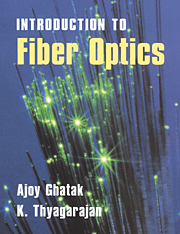Book contents
- Frontmatter
- Contents
- Preface
- Acknowledgments
- Abbreviations
- 1 Introduction: The fiber optics revolution
- 2 Basic optics
- 3 Basic characteristics of the optical fiber
- 4 Ray paths and pulse dispersion in planar optical waveguides
- 5 Pulse dispersion in graded index optical fibers
- 6 Material dispersion
- 7 Modes in planar waveguides
- 8 Propagation characteristics of a step index fiber
- 9 Propagation characteristics of graded index fibers
- 10 Waveguide dispersion and design considerations
- 11 Sources for optical fiber communication
- 12 Detectors for optical fiber communication
- 13 Design considerations of a fiber optic communication system
- 14 Optical fiber amplifiers
- 15 Dispersion compensation and chirping phenomenon
- 16 Optical solitons
- 17 Single-mode fiber optic components
- 18 Single-mode optical fiber sensors
- 19 Measurement methods in optical fibers: I
- 20 Measurement methods in optical fibers: II
- 21 Periodic interactions in waveguides
- 22 The ray equation in cartesian coordinates and its solutions
- 23 Ray paths and their classification in optical fibers
- 24 Leaky modes
- Appendix A Solution of the scalar wave equation for an infinite square law medium
- Appendix B The far-field pattern
- Appendix C WKB analysis of multimode fibers
- Appendix D Gaussian envelope approximation
- Appendix E Coupled-mode equations
- Appendix F Derivation of coupled-mode equation for periodic coupling
- Appendix G Leakage loss in optical waveguides
- References
- Index
1 - Introduction: The fiber optics revolution
Published online by Cambridge University Press: 05 June 2012
- Frontmatter
- Contents
- Preface
- Acknowledgments
- Abbreviations
- 1 Introduction: The fiber optics revolution
- 2 Basic optics
- 3 Basic characteristics of the optical fiber
- 4 Ray paths and pulse dispersion in planar optical waveguides
- 5 Pulse dispersion in graded index optical fibers
- 6 Material dispersion
- 7 Modes in planar waveguides
- 8 Propagation characteristics of a step index fiber
- 9 Propagation characteristics of graded index fibers
- 10 Waveguide dispersion and design considerations
- 11 Sources for optical fiber communication
- 12 Detectors for optical fiber communication
- 13 Design considerations of a fiber optic communication system
- 14 Optical fiber amplifiers
- 15 Dispersion compensation and chirping phenomenon
- 16 Optical solitons
- 17 Single-mode fiber optic components
- 18 Single-mode optical fiber sensors
- 19 Measurement methods in optical fibers: I
- 20 Measurement methods in optical fibers: II
- 21 Periodic interactions in waveguides
- 22 The ray equation in cartesian coordinates and its solutions
- 23 Ray paths and their classification in optical fibers
- 24 Leaky modes
- Appendix A Solution of the scalar wave equation for an infinite square law medium
- Appendix B The far-field pattern
- Appendix C WKB analysis of multimode fibers
- Appendix D Gaussian envelope approximation
- Appendix E Coupled-mode equations
- Appendix F Derivation of coupled-mode equation for periodic coupling
- Appendix G Leakage loss in optical waveguides
- References
- Index
Summary
There has always been a demand for increased capacity of transmission of information, and scientists and engineers continuously pursue technological routes for achieving this goal. The technological advances ever since the invention of the laser in 1960 have indeed revolutionized the area of telecommunication and networking. The availability of the laser, which is a coherent source of light waves, presented communication engineers with a suitable carrier wave capable of carrying enormously large amounts of information compared with radiowaves and microwaves. Although the dream of carrying millions of telephone (audio) or video channels through a single light beam is yet to be realized, the technology is slowly edging toward making this dream a reality.
A typical lightwave communication system consists of a lightwave transmitter, which is usually a semiconductor laser diode (emitting in the invisible infrared region of the optical spectrum) with associated electronics for modulating it with the signals; a transmission channel – namely, the optical fiber to carry the modulated light beam; and finally, a receiver, which consists of an optical detector and associated electronics for retrieving the signal (see Figure 1.1). The information – that is, the signal to be transmitted – is usually coded into a digital stream of light pulses by modulating the laser diode. These optical pulses then travel through the optical fiber in the form of guided waves and are received by the optical detector from which the signal is then decoded and retrieved.
- Type
- Chapter
- Information
- An Introduction to Fiber Optics , pp. 1 - 8Publisher: Cambridge University PressPrint publication year: 1998
- 2
- Cited by



